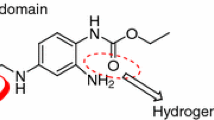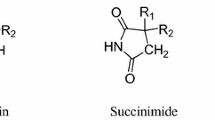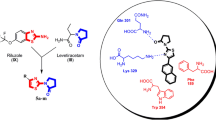Anticonvulsive activities of some condensed imidazo[1,2-a]benzimidazole derivatives were predicted using PASS software. Benzimidazoles as a class showed promise as sources of anticonvulsants. Several compounds demonstrated various levels of anticonvulsive activity in the corazole-induced seizure model (75 mg/kg, s.c.). The most promising compounds (laboratory codes RU-1205, RU-285, RU-1204, and RU-1203) at a dose of 10 mg/kg (i.p.) showed high levels of anticonvulsive activity comparable with that of reference valproic acid (130 mg/kg, i.p.) at a molar ratio of ~1:30. The Free—Wilson model was used to describe quantitative structure—activity relationships in order to evaluate contributions of substituents or structural fragments to the anticonvulsive activity of the parent structure. Four pharmacophore patterns that favored high anticonvulsive activity among imidazo[1, 2-a]benzimidazole derivatives were found using IT Microcosm.
Similar content being viewed by others
Convulsive syndromes are common psychoneurological pathologies that afflict over 70 million people worldwide [1]. Even modern anticonvulsants achieve remission in only 60% of aged patients whereas the incidence of pharmaceutically resistant disease in children is significantly greater [2]. Furthermore, the majority of anticonvulsants have pronounced side effects that degrade the quality of life for patients. Thus, it seemed crucial to seek and discover new medicines that were more efficacious and had less risk of developing side effects [3].
Research and development of biologically active heterocyclic compounds, e.g., benzimidazole derivatives, is an active topic in the design of new anticonvulsants. Benzimidazole and its derivatives exhibit broad spectra of biological activity because they are structurally similar to the nucleic-acid purine bases adenine and guanine [4]. They were reported to have psychotropic [5, 6] and anticonvulsant properties [7,8,9]. Also, several benzimidazole derivatives were found to interact with GABAA-receptors, which play a pivotal role in regulating nervous excitation [10].
Several benzimidazole derivatives, i.e., substituted imidazo[1,2-a]benzimidazoles (ImBI), displayed various types of psychotropic activity. Several compounds modulated neural ion currents, which could be responsible for the anticonvulsive activity [11].
The goal of the present work was to discover new imidazo[1,2-a]benzimidazole derivatives with anticonvulsive activity.
Experimental Part
The novel compounds were synthesized at the Institute of Physical and Organic Chemistry, Southern Federal University (IPOC, SFU). The studies were conducted according to good laboratory practices (GLP) and Article 11 of Federal Law No. 61-FZ dated April 12, 2010, “On Drug Circulation” (Collection of Russian Federation Legislation, 2010, No. 16, Art. 1815; No. 31, Art. 4161). All experiments were carried out according to a decision of an ethics review dated Dec. 17, 2011, protocol No. 149 – 2012.
The spectra of biological activity were predicted in silico using PASS (version 10.4) software that operated by analyzing a training set of 266,697 organic compounds with known types of biological activities. The prediction method used in PASS was described in detail before [12, 13].
Experiments in vivo were performed by the usual procedure [14] using white outbred mice (20 – 25 g) from a laboratory in the Department of Pharmacology, Volgograd State Medical University (Volgograd, Russia). Animals were maintained under standard vivarium conditions with a 12-hour light regime and free access to water and food according to GOST R 50258-92. Laboratory practice rules for preclinical trials in the RF that are regulated by GOST R 51000.3-96 and GOST R 51000.4-96 and international recommendations of the European Convention on the Protection of Invertebrate Animals Used for Experimental or Other Scientific Purposes were observed.
Test groups of animals (n = 10) were injected i.p. with the studied compounds at a screening dose of 10 mg/kg that did not visibly disrupt locomotor activity. Animals in the positive control group (n = 10) received valproic acid (Convulex, Gerot Pharmazeutika, Austria) at a dose of 130 mg/kg i.p. [15]. The negative control group (n = 10) were injected i.p. with equivalent amounts of solvent (distilled H2O).
Seizures in the animals were modeled by a single s.c. injection of corazole (Sigma, USA) in the cervical spinal region at a dose of 75 mg/kg 60 min after injection of the test compound or solvent.
The manifestation of anticonvulsive activity and lethality was observed for 30 min. Animals that did not display for 30 min repetitive clonic convulsions of duration 3 sec after administration of the compound and then corazole were considered to be protected.
(Q)SARs of the studied compounds that were determined by the Free–Wilson method [16] provided a framework for assessing the contributions of base structures and substituents in series of N9- and N1-derivatives to the level of anticonvulsive activity.
Pharmacophores were analyzed using IT Microcosm (FarmFor module) information technology for predicting the biological activities of chemical compounds [17]. Pharmacophores with high anticonvulsive activity that were combinations of traditional pharmacophore substructures were constructed.
Results were processed statistically using Graphpad Prizm software. Obtained values were compared using dispersion analysis. Changes were considered statistically significant for p ≤ 0.05.
Results and Discussion
Predictions using the PASS software. A database of 647 compounds of the general structural formula shown in Fig. 1-I included 520 N9- and 127 N1-substituted derivatives and was compiled using structural data for condensed azole derivatives from the Department of Pharmacology, VSMU, in order to assess the potential of ImBI derivatives as sources of anticonvulsants using PASS software (version 10.4).
An analysis of the computationally predicted potential (Fig. 1, I) that the compounds would manifest effects and mechanisms of action associated with anticonvulsive activity (Table 1) showed that in general the ImBI derivatives were highly promising for discovering compounds with anticonvulsant properties because 88% of all 647 analyzed structures displayed some kind of anticonvulsive activity in the PASS predicted spectrum regardless of N1 and N9 positions. Both classes were promising for discovering novel anticonvulsants according to the in silico assessment of the presence of anticonvulsive activity (Table 1, first line). However, this effect was predicted for more N9-substituted ImBI derivatives (71.3%) than for N1-substituted ones (60.6%).
Differences between the series were found by examining the computationally predicted molecular mechanisms of anticonvulsive activity. According to PASS estimates, both N1- and N9-ImBI were presumed to exert their anticonvulsive activity by blocking sodium channels. The probability of this mechanism of action was slightly greater for the N9-derivatives (20.0%) than for the N1-derivatives (15.0%).
A second common mechanism for the N1- and N9-ImBI derivatives according to the in silico predictions could have been agonistic activity for GABAA-receptors. However, in this instance the N1-substituted ImBI derivatives had a higher predicted value (78.7%) than N9-substituted ones (66.0%). A third mechanism found from the PASS prediction was inhibition of GABA recapture that was characteristic only of N1-ImBI.
In general, the ImBI derivatives seemed promising for discovering anticonvulsants according to the activity spectra predicted by PASS. According to the in silico estimates, the mechanism for manifesting the anticonvulsive activity probably differed slightly for the N1- and N9-substituted compounds. According to the computer prediction of the anticonvulsive effect itself (Table 1, first line), the N9-ImBI class was more preferred for discovering novel anticonvulsants than the N1-ImBI class.
Experimental testing. The 2-(4-phenyl) ImBI derivatives were selected for the experimental search for pharmacological activity using the corazole-induced seizure model. These and related compounds showed high levels of anticonvulsive activity in various studies [8,19,, 9, 18–20]. A total of 15 water-soluble compounds including 8 N9-substituted ImBI derivatives (Fig. 1, II) and 7 N1-substituted ones (Fig. 1, III) were selected. According to the PASS-computed predictions, all these compounds should have exhibited the following types of activity that were most probable for ImBI, i.e., anticonvulsive and/or GABAA-agonist and/or sodium channel blockade. Table 2 presents the experimental results.
All control animals that received solvent developed seizures after corazole injection (75 mg/kg) in the following sequence. 1. One or more myoclonic twitches of the whole body. 2. Repetitive clonic seizures of the fore and/or hind paws lasting >3 sec without losing the rollover reflex. 3. Generalized clonic seizures of fore and hind paws with loss of the rollover reflex. 4. Tonic extensions of fore paws with loss of rollover reflex. 5. Tonic extension of fore and hind paws with loss of the rollover reflex. Seizures described in points 1 – 3 were consistently observed in 90 – 100% of the control animals after corazole injection. The negative control group reached 100% lethality immediately after the fifth stage of the seizure syndrome.
Valproic acid (130 mg/kg) suppressed development of clonic convulsions lasting >3 sec in 50% of the animals. This was statistically significantly greater than the negative control group (p < 0.05). The lethality in this group was 25%.
The tested compounds affected to different extents the development of seizure syndrome and the incidence of lethal outcomes. Compounds with laboratory codes RU-1205 (50%), RU-285 (40%), RU-1204 (40%), and RU-1203 (40%) exhibited the most pronounced ability to block clonic convulsions lasting >3 sec. The values were statistically significant relative to the negative control group (p < 0.05). Compound RU-1205 prevented the deaths of 80% of the animals. Compounds RU-67, RU-87, and RU-1359 diminished the lethality equally as well as the reference drug.
Free—Wilson analysis. Groups that altered considerably the electron-density distribution in a phenyl ring, e.g., Cl, F, Br, CH3O, etc., were examined in addition to positional changes of the N1- and N9-substituents and variations of their types in order to ensure that the set was representative. Several of them were distinctly electronegative (e.g., F); others, electropositive (e.g., CH3O). Thus, a set of groups on the benzene ring of 2-phenylimidazobenzimidazole that varied sufficiently the electron density on this scaffold was examined.
Free—Wilson analysis of the contributions of substituents and the ImBI base structure to the anticonvulsive activity and the survival parameter was performed for 15 experimentally studied compounds (Table 2). Table 3 presents the results for four highly significant QSAR plots (p < 0.01).
The Free—Wilson model assumed that the variable characterizing the biological activity was continuous although the percent anticonvulsive effects in Table 3 that are generally accepted in pharmacology were qualitative in nature. However, this violation of the boundary condition had to be ignored in order to obtain numerical values for the contributions of substituents and base structures to the ImBI anticonvulsive activity. Furthermore, the contributions of most substituents were computed at one or two points because of the small size of the training set. Therefore, data obtained from Free—Wilson modeling were also treated as qualitative. Their relative ratios should be considered not quantitative but reflective of one tendency or another.
An analysis of the substituent contributions to the anticonvulsive activity showed that 2-(4-fluoro), 9-morpholinoethyl, and 9-pyrrolidinoethyl in N9-substituted ImBI possessed pronounced positive effects; 2-(4-chloro), a moderate effect. For N1-substituted ImBI, 1-(3-bromopropyl) had a pronounced positive contribution to the activity; 2-(4-fluoro), 2-(4-bromo), and 1-piperidinopropyl, a characteristic moderate positive effect.
The contribution of the base structure to the anticonvulsive activity was much greater for N9-ImBI than for N1-ImBI.
With respect to survival, substituents with a clearly pronounced positive increment were not found among the N9-ImBI derivatives. All five substituents with positive effects, i.e., 2-(4-methoxy), 2-(4-hydroxy), 2-(4-fluoro), 9-morpholinoethyl, and 9-allyl, contributed moderately to the total activity. Conversely, three substituents, i.e., 2-(4-fluoro), 1-(3-bromopropyl), and 1-diethylaminopropyl, had pronounced positive contributions in the N1-derivatives. 1-Morpholinopropyl possessed a moderate positive effect.
The contribution of the base structure to the survival parameters was also greater for N9-ImBI than for N1-ImBI.
A comparison of the parameters for the two series showed the following. The base structure of N9-substituted ImBI contributed greatly to the anticonvulsive activity and was more accommodating to the introduction of substituents that increased it. Three substituents had pronounced positive effects; one, a moderately positive effect. The base structure of N1-substituted ImBI contributed much less to the activity and was less accommodating to the introduction of substituents. Only one substituent had a pronounced positive effect; three, moderately positive effects.
The base structure of N9-substituted ImBI also contributed greatly to the survival parameter but was not very accommodating to the introduction of substituents increasing it. All five substituents had moderate positive effects. The base structure of N1-substituted ImBI contributed less to the activity but was more accommodating to the introduction of substituents increasing it. Three substituents had pronounced positive effects; one, a moderate effect.
Thus, the parameter sets of N9-substituted ImBI were more promising than those of N1-substituted ImBI for discovering compounds with high anticonvulsive activity. The base structure of the N9-derivatives made substantial contributions to both the anticonvulsive activity and the survival parameter although it was more sensitive to the introduction of substituents that increased the anticonvulsive activity.
It is noteworthy that these final results from the Free—Wilson analysis agreed well with the predictions obtained using the PASS software.
Pharmacophore analysis. Statistically significant signatures of high anticonvulsive activity (p < 0.05) were found for the whole studied series of compounds using IT Microcosm. Then, pharmacophores were formulated based on them (Table 4).
Four common signatures providing rather high levels of anticonvulsive activity regardless of the position of the substituent on the tricyclic N atoms were obtained in addition to the local trends that were found previously for the N1- and N9-ImBI series.
Thus, the pharmacophore analysis allowed highly reliable integral structural signatures of the presence of anticonvulsive activity to be determined for compounds of the ImBI class.
A complex (Q)SAR analysis of the anticonvulsive activity as a function of the chemical structure of the ImBI derivatives was performed by Free—Wilson and pharmacophore analysis in IT microcosm using the PASS software.
Promising compounds (RU-1205, RU-285, RU-1204, and RU-1203) that showed high levels of anticonvulsive activity that were comparable with that of the reference drug valproic acid with respect to the ability to prevent clonic seizures in the corazole-induced seizure model at an ~1:30 molar ratio of test compound to reference drug were found.
It was demonstrated that the ImBI derivatives were a promising class for seeking compounds with anticonvulsive activity. Several N9-substituted ImBI were more promising than N1-substituted ImBI as platforms for compounds with high anticonvulsive activity.
A 4-fluoro substituent in the 2-position and a dialkylaminoalkyl or cycloalkylaminoalkyl substituent in the ImBI 9-position were distinguishing features of highly active compounds.
The obtained QSAR trends could be used to design and focus the search for novel highly active anticonvulsants on ImBI derivatives.
References
M. J. Brodie, S. C. Schachter, and P. K. L. Kwan, Fast Facts: Epilepsy, Health Press, Albuquerque, New Mexico, USA (2012).
S. Remy and H. Beck, Brain, 129(1), 18 – 35 (2006).
R. J. A. de Kinderen, S. M. A. A. Evers, R. Rinkens, et al., Seizure, 23(3), 184 – 190 (2014).
D. Pathak, N. Siddiqui, B. Bhrigu, et al., Pharm. Lett., 2(2), 27 – 34 (2010).
L. I. Bugaeva, A. A. Spasov, V. E. Verovskii, and I. N. Iezhitsa, Eksp. Klin. Farmakol., 63(6), 53 – 57 (2000).
T. V. Gamma, I. I. Korenyuk, and D. R. Khusainov, Neuro- and Psychotropic Effects of Benzimidazole and Its Derivatives [in Russian], Lambert Academic Publishing, Saarbrucken (2012), pp. 46 – 80.
R. V. Shingalapur, K. M. Hosamani, R. S. Keri, and M. H. Hugar, Eur. J. Med. Chem., 45(5), 1743 – 1759 (2010).
K. Yu. Kalitin, O. Yu. Grechko, A. A. Spasov, and V. A. Anisimova, Eksp. Klin. Farmakol., 78(4), 3 – 5 (2015).
A. A. Spasov, K. Yu. Kalitin, O. Yu. Grechko, and V. A. Anisimova, Byull. Eksp. Biol. Med., 160(9), 320 (2015).
P. Jain, P. K. Sharma, H. Rajak, et al., Arch. Pharm. Res., 33(7), 971 – 980 (2010).
V. A. Anisimova, A. A. Spasov, V. A. Kosolapov, et al., Khim.-farm. Zh., 39(9), 26 – 32 (2005); Pharm. Chem. J., 39(9), 476 – 483 (2005).
D. A. Filimonov, A. A. Lagunin, T. A. Gloriozova, et al., Chem. Heterocycl. Compd., 50(3), 444 – 457 (2014).
URL www.way2drug.com/passonline
A. N. Mironov (ed.), Handbook for Preclinical Drug Trials [in Russian], Part 1, Grif i K, Moscow (2012), pp. 235 – 250.
J. J. Luszczki, J. Pre-Clin. Clin. Res., 2(1), 40 – 45 (2008).
H. Kubinyi, Quant. Struct.-Act. Relat., 7(3), 121 – 133 (1988).
P. M. Vassiliev, A. A. Spasov, V. A. Kosolapov, et al., in: Application of Computational Techniques in Pharmacy and Medicine, L. Gorb, V. Kuz’min, and E. Muratov (eds.), Challenges and Advances in Computational Chemistry and Physics 17, J. Leszczynski (ed.), Springer Science+Business Media, Dordrecht (2014), pp. 369 – 431, 550.
B. Bhrigu, N. Siddiqui, D. Pathak, et al., Acta Pol. Pharm. Drug Res., 69(1), 53 – 62 (2012).
G. Akula, B. Srinivas, M. Vidyasagar, et al., Int. J. PharmTech Res., 3, 360 – 364 (2011).
N. Kumar, P. K. Sharma, V. K. Garg, et al., Curr. Res. Chem., 3(2), 114 – 120 (2011).
Acknowledgments
The synthesis of the chemical compounds was sponsored by the project part of a state task for scientific activity (No. 4.196.2014/K) and was performed using equipment at the Molecular Spectroscopy CCU, SFU. Activities were predicted using PASS within the framework of the Basic Research Program of State Academies of Sciences for 2014 – 2020 (Topic No. 3).
Author information
Authors and Affiliations
Additional information
Translated from Khimiko-Farmatsevticheskii Zhurnal, Vol. 50, No. 12, pp. 3 – 8, December, 2016.
Rights and permissions
About this article
Cite this article
Vasil’ev, P.M., Kalitin, K.Y., Spasov, A.A. et al. Prediction and Study of Anticonvulsant Properties of Benzimidazole Derivatives. Pharm Chem J 50, 775–780 (2017). https://doi.org/10.1007/s11094-017-1530-6
Received:
Published:
Issue Date:
DOI: https://doi.org/10.1007/s11094-017-1530-6





